Almost five years ago (1/27/13) I published a post entitled “A Guide To Aging Bald Eagles”. With over 71,000 views to date that post has been my most popular so I decided it was overdue for an update and enhancements. For this version I’ve made the following changes:
- much of the text has been rewritten for purposes of accuracy and clarification
- three images have been added
- a section about distinguishing immature Bald Eagles from Golden Eagles has been included
- formatting has been cleaned up and the title modified
As we approach prime eagle watching season here in northern Utah I thought it might be timely to present a guide that would be helpful in aging Bald Eagles as they progress through the 5-6 year plumage stages of becoming those glorious white-headed and white-tailed adults we’re all so familiar with. And since many immature Bald Eagles so strongly resemble Golden Eagles I’ve included information and photos that should be helpful in distinguishing the two.
Raptors, including eagles, that have not reached the adult plumage stage are referred to as immature. Those in their first plumage stage are called juveniles and the term sub-adult is used to refer to any plumage stage between juvenile and adult. Depending on molt sequence, age and timing plumage stages are highly variable so other factors like iris and beak color are also taken into account when estimating age. Eyes gradually change from dark brown to yellow while the beak goes from blackish-gray to yellow as they mature.
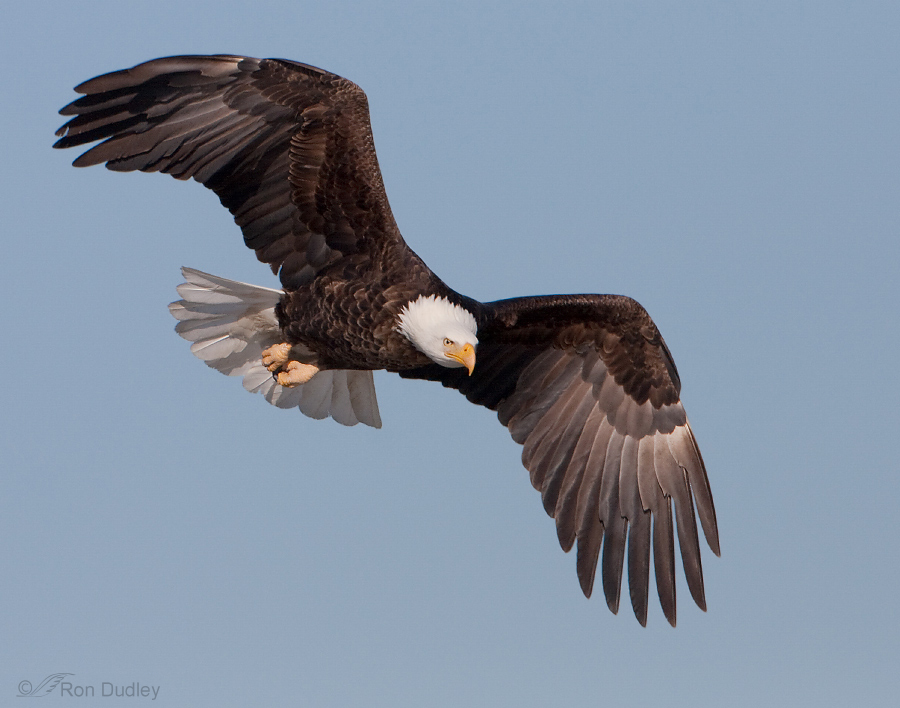
1/4000, f/8, ISO 500, 500 f/4, not baited, set up or called in
The adult Bald Eagle is unmistakable with its distinctive bright white head and tail contrasting with the dark brown body and wings.
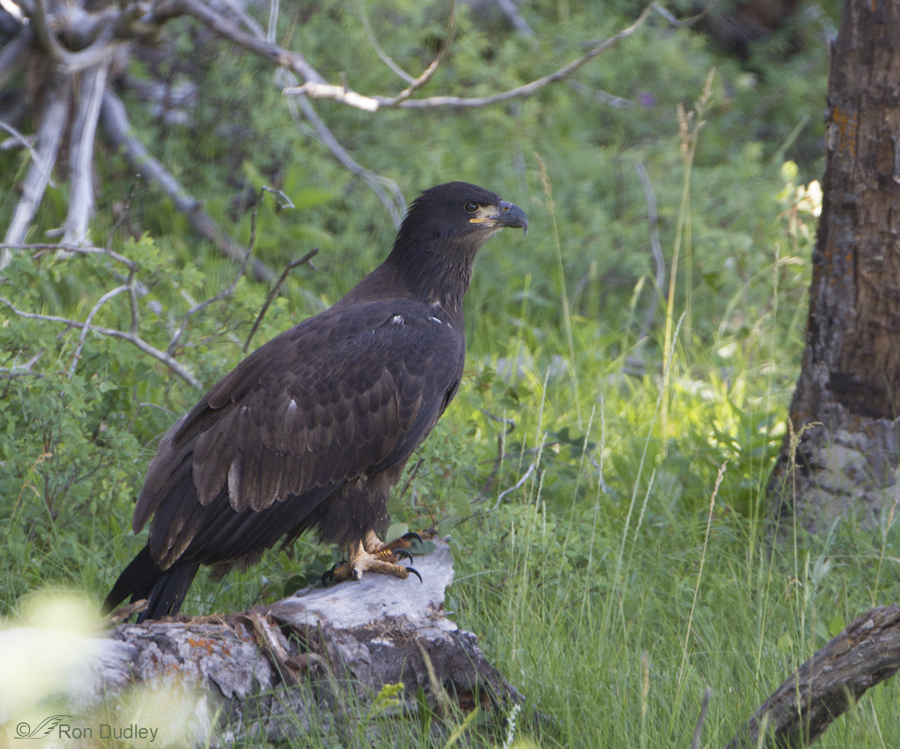
1/200, f/6.3, ISO 800, 500 f/4, 1.4 tc, not baited, set up or called in
But immature Bald Eagles present very differently than adults, especially in the early stages of development. This juvenile is barely fledged and was still hanging around its nest in southwest Montana. Notice that the plumage is dark brownish-black throughout, though they may have some white or pale mottling at this stage especially on the underparts. Both eye and beak are very dark.
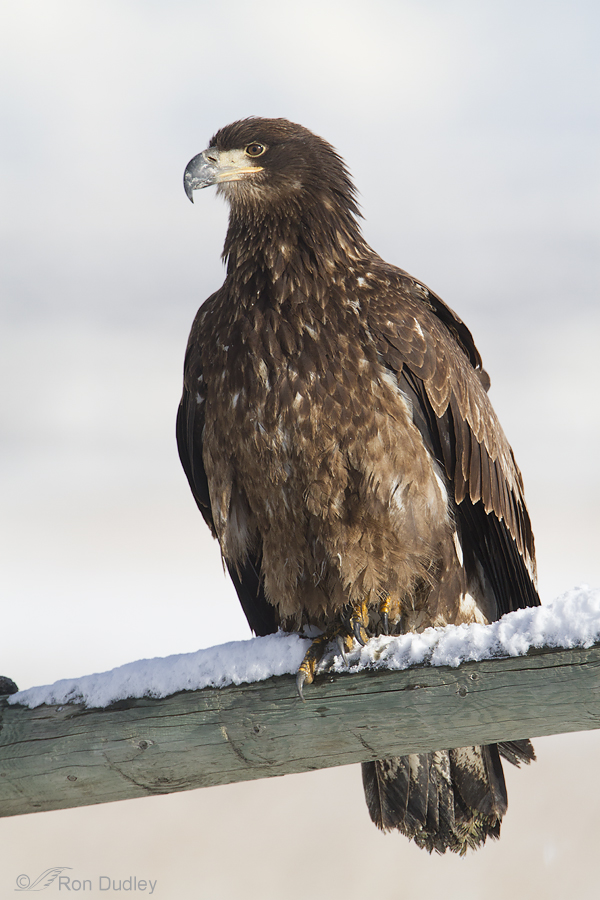
1/2000, f/6.3, ISO 500, 500 f/4, 1.4 tc, not baited, set up or called in
This is a first year bird during winter. There’s already some color change in the eye.
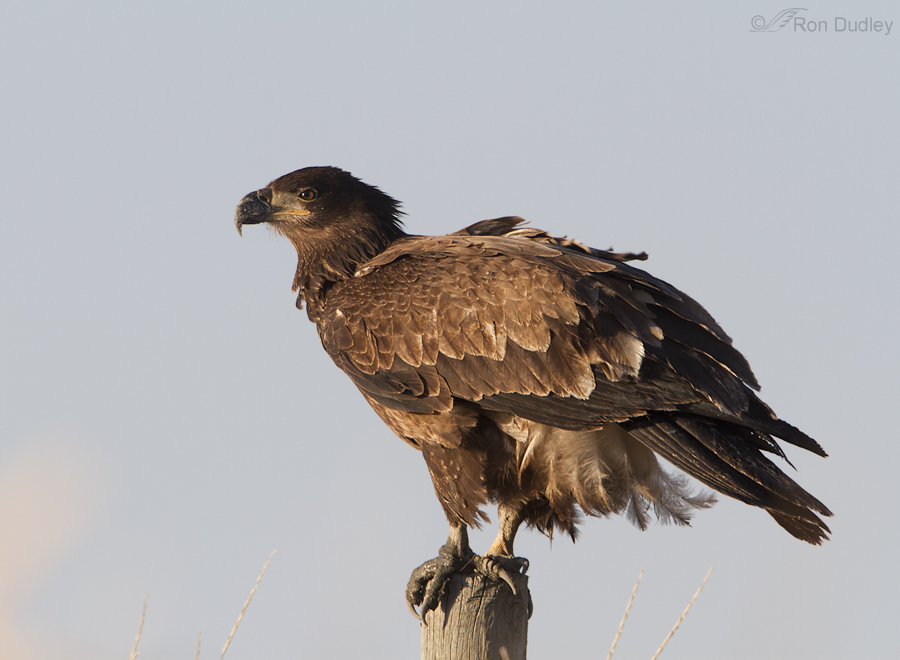
1/800, f/8, ISO 500, 500 f/4, natural light, not baited, set up or called in
A side view of the same bird as in the previous image. The warm, early morning light gives it a bit of a golden glow that wouldn’t normally be seen. This stage in particular is often confused with the Golden Eagle.
1/3200, f/8, ISO 500, 500 f/4, not baited, set up or called in
Plumage colors after the first year become increasingly variable. There is more white mottling ventrally and the beak and cere are becoming less dark.
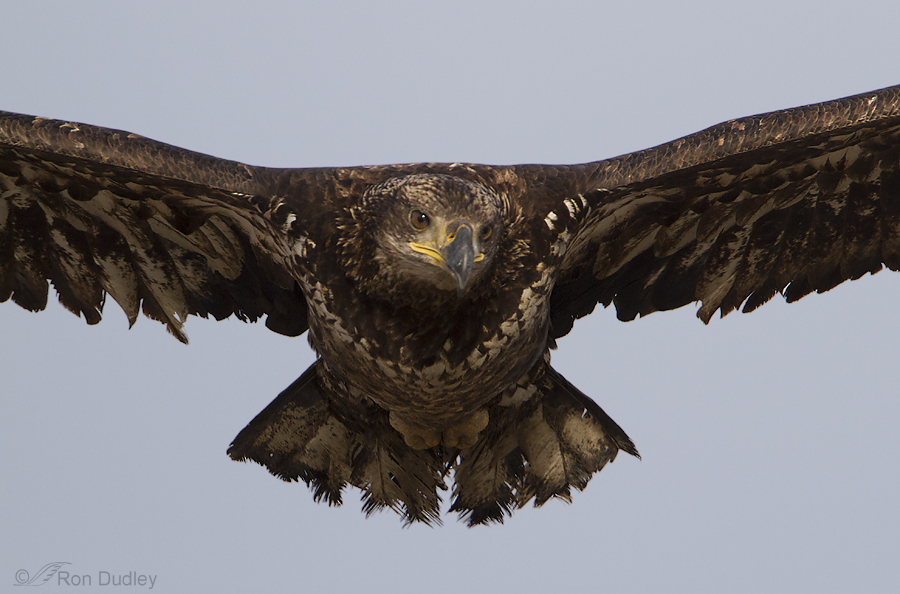
1/1600, f/6.3, ISO 500, 500 f/4, 1.4 tc, not baited, set up or called in
The iris is beginning its transformation to yellow and there’s also some yellow at the base of the beak.
1/1250, f/7.1, ISO 500, 500 f/4, 1.4 tc, not baited, set up or called in
As plumage stages develop through the second and third sub-adult years the tail becomes whiter with a dark terminal band and more white appears elsewhere. The beak is less dark and as the head becomes lighter it generally leaves a darker “eye stripe”.
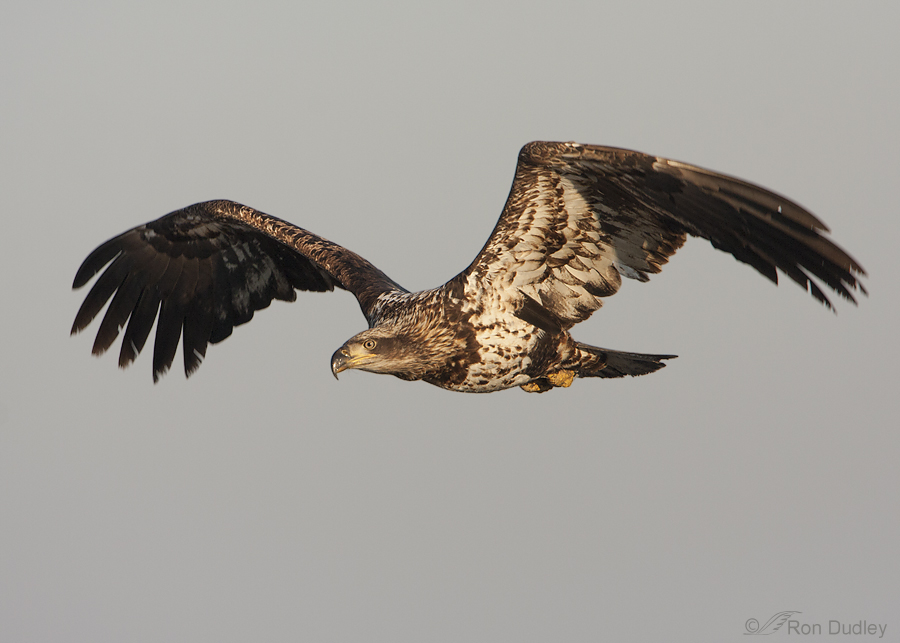
1/1000, f/8, ISO 500, 500 f/4, 1.4 tc, not baited, set up or called in
The eye is becoming more yellow and the eye-stripe is quite distinctive and often similar to that of an Osprey.
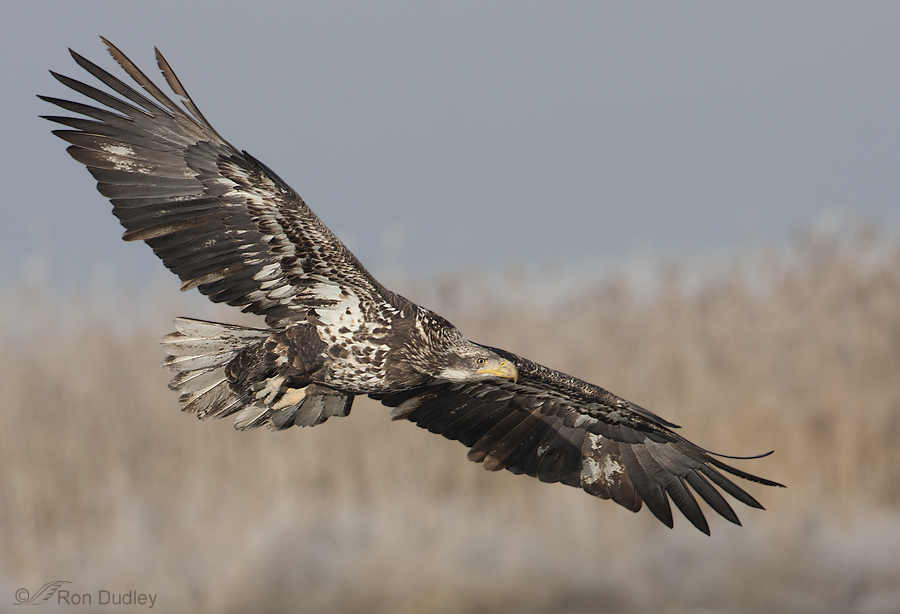
1/1600, f/8, ISO 500, 500 f/4, not baited, set up or called in
The beak is becoming more yellow (though not as bright as in the adult). Some birds at this stage (like this one) exhibit a few secondary flight feathers that are longer than the rest at the trailing edge of the wing.
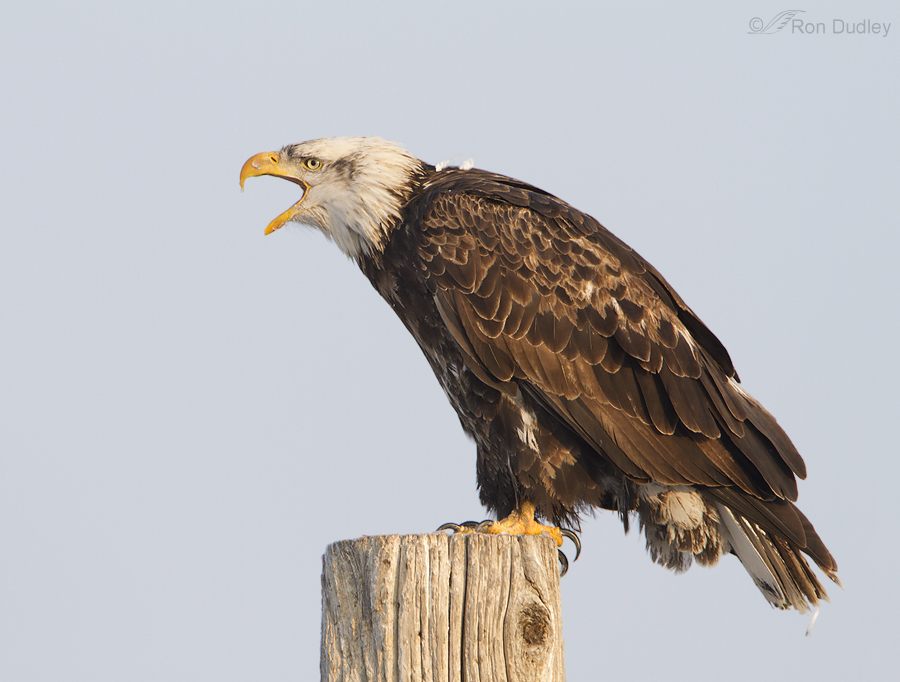
1/640, 7.1, ISO 800, 500 f/4, 1.4 tc, not baited, set up or called in
By the fourth year (though there’s much variation) they’re in transition from immature plumage to full adulthood. The head is mostly white with some dark flecking especially around the eye and forehead near the cere. The tail now lacks the dark terminal band and the beak is nearly completely yellow.
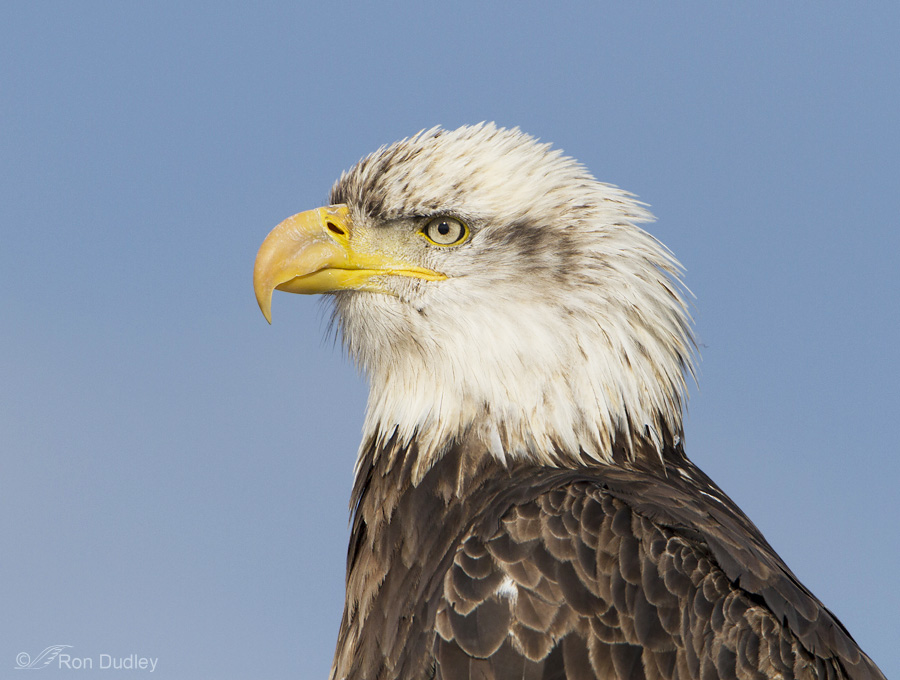
1/2500, f/8, ISO 500, not baited, set up or called in
A closer look at the same bird allows a better view of the detail of the dark flecking and the beak and eye color at this stage.
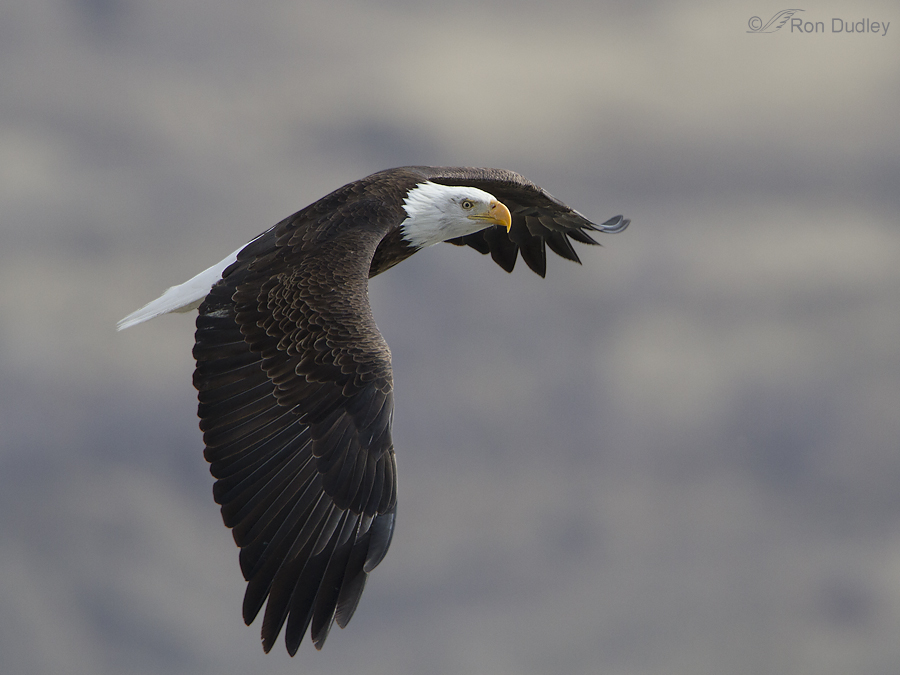
1/1600, f/6.3, ISO 500, 500 f/4, 1.4 tc, not baited, set up or called in
This bird is very nearly in full adult plumage. The tail is now bright white but there remains a small amount of dark flecking on the head.
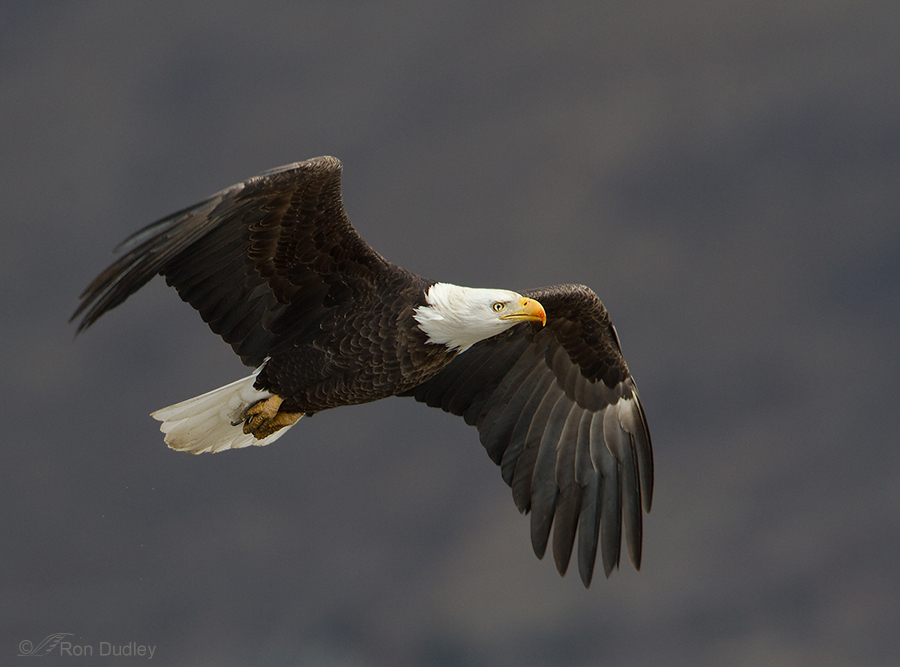
1/1250, f/7.1, ISO 500, 500 f/4, 1.4 tc, not baited, set up or called in
A fully mature adult. Both head and tail are now completely white with overall dark brown plumage elsewhere. This bird has fish blood on its beak and if you look closely you’ll see that it has a “blown eye” (misshapen pupil, possibly due to injury).
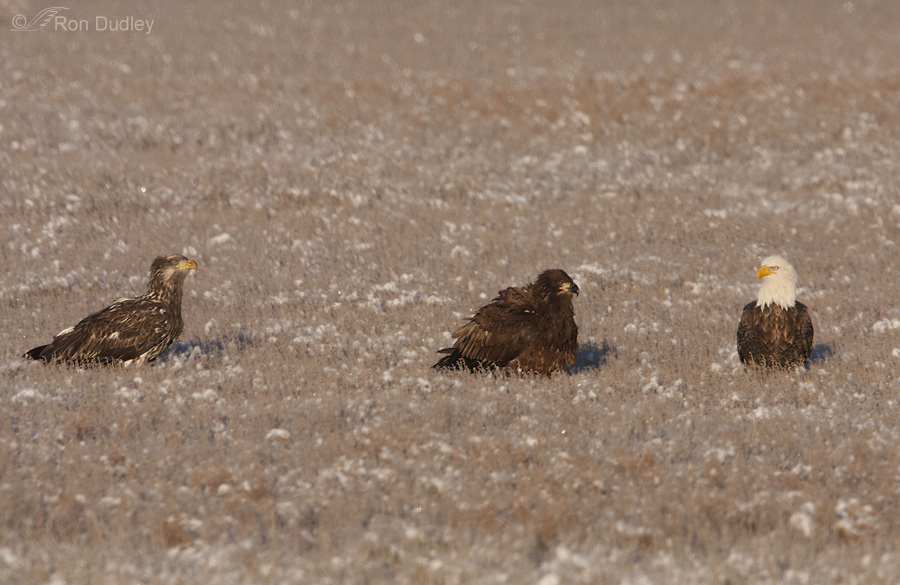
1/1600, f/8, ISO 500, 500 f/4, 1.4 tc, not baited, set up or called in
Here we can compare three plumage stages of Bald Eagles in one photo – a sub-adult on the left, a juvenile in the middle and a mature adult on the right.
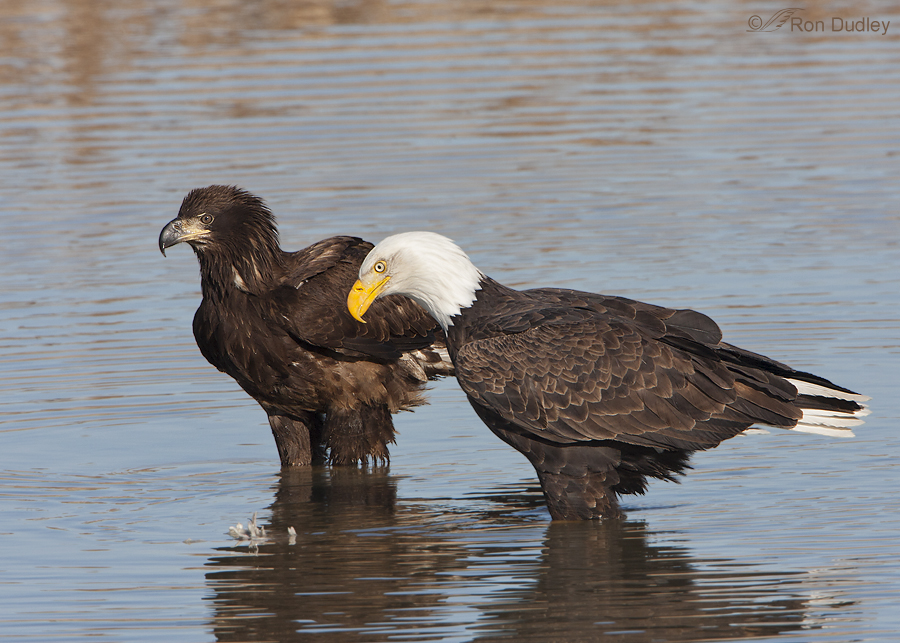
1/800, f/11, ISO 500, 500 f/4, 1.4 tc, not baited, set up or called in
An adult and a first winter juvenile up close.
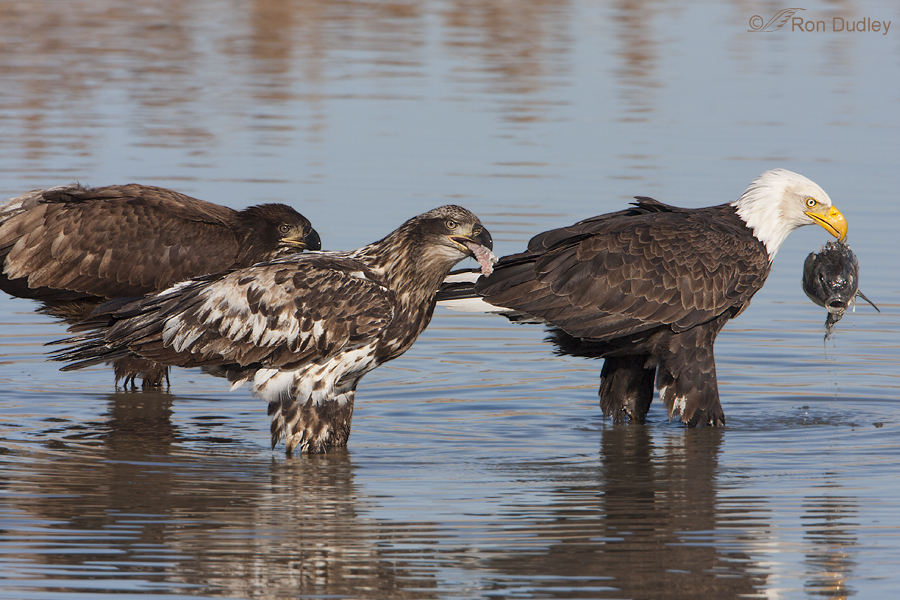
1/1000, f/11, ISO 500, 500 f/4, 1.4 tc, not baited, set up or called in
An adult on the right, a juvenile on the left and a sub-adult with some interesting mottling in the middle.
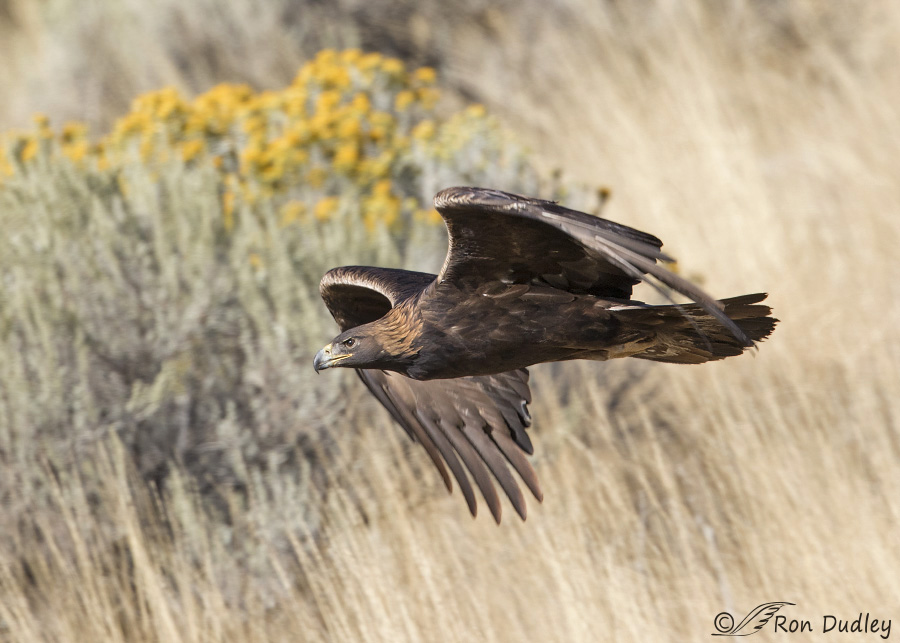
1/1250, f/7.1, ISO 640, not baited, set up or called in
One of the most common ID errors I see in the field is folks confusing immature Bald Eagles with Golden Eagles (the image above is of a Golden Eagle). Almost invariably novices will call any very large dark raptor a Golden Eagle while in most North American habitats it’s much more likely to be an immature Bald. Here are some guidelines that can be used to distinguish Goldens from immature Balds.
- Golden Eagles have a distinctive golden nape (back of neck) that is usually easily seen in direct light and is completely lacking in Bald Eagles of any age.
- Though it can’t be seen well in this photo the legs of Golden Eagles are feathered all the way down to the toes while the lower legs (tarsi) of Bald Eagles are not feathered.
- Typical of most fishing eagles Bald Eagles have a very large bill, noticeably larger than that of Golden Eagles.
There are other more subtle plumage differences that I’ve chosen not to include here.
1/1600, f/7.1, ISO 500, not baited, set up or called in
Another helpful tool is behavior and habitat. Golden Eagles very rarely feed on fish and as a result they’re less likely to be found in aquatic habitats so if the eagle you’re attempting to ID is associated with fish, fishing or aquatic habitats it’s very likely to be an immature Bald Eagle. That’s not an absolute guarantee but it’s a helluva clue.
For many of us Bald Eagle season is almost upon us so I hope these tips and guidelines will be helpful to my readers. After all, no one wants to misidentify an eagle of either species!
Ron
Notes:
- For this updated version I’ve used several resources for guidance including “Birds Of North America Online”, my own photos and knowledge and friend and raptor expert Jerry Liguori’s excellent book “Hawks From Every Angle – How To Identify Raptors In Flight”.
- It’s possible that the third and fourth photos from the bottom in this series were baited. I learned after the fact that on some days photographers had been moving some of the carp the eagles were feeding on to more photogenic locations. I don’t believe the birds in these two images were baited, but it is possible.
- I believe all of the images in this post were taken with my Canon EF 500mm f/4L IS USM lens (either version I or version II) though I ran out of time to verify. Most of the photos were taken at Farmington Bay WMA in northern Utah.


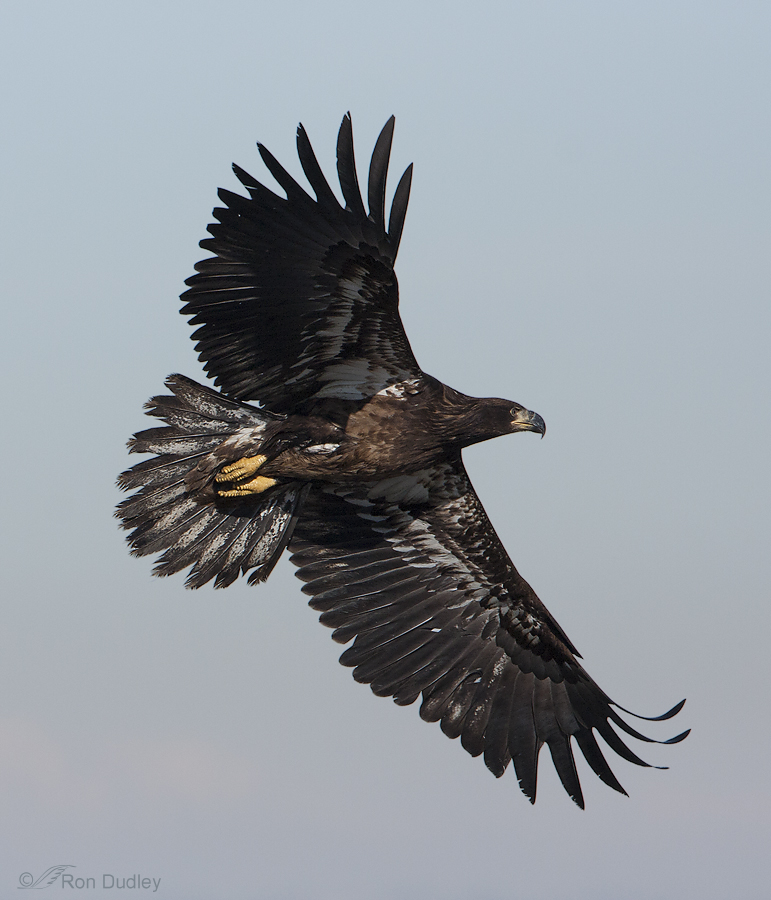
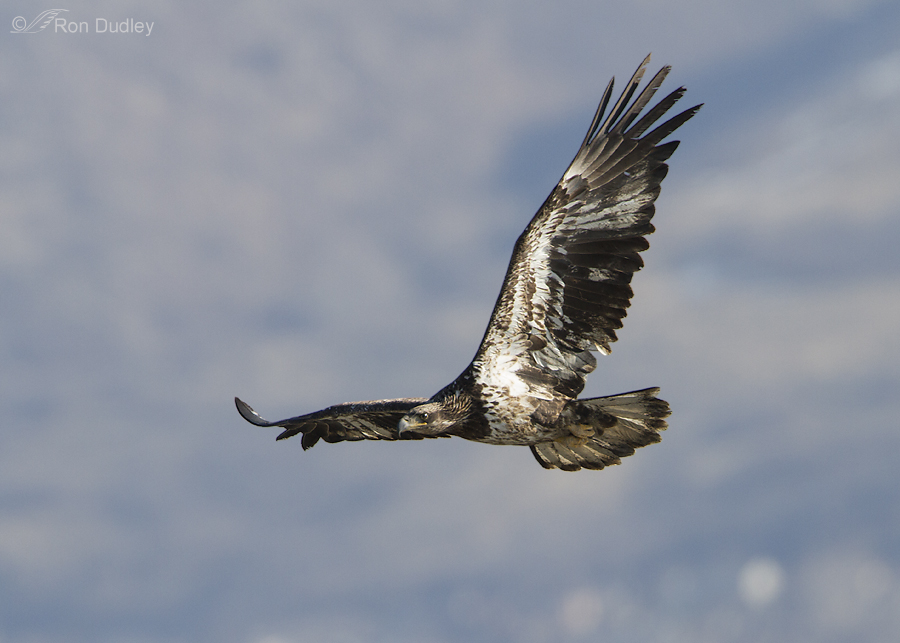
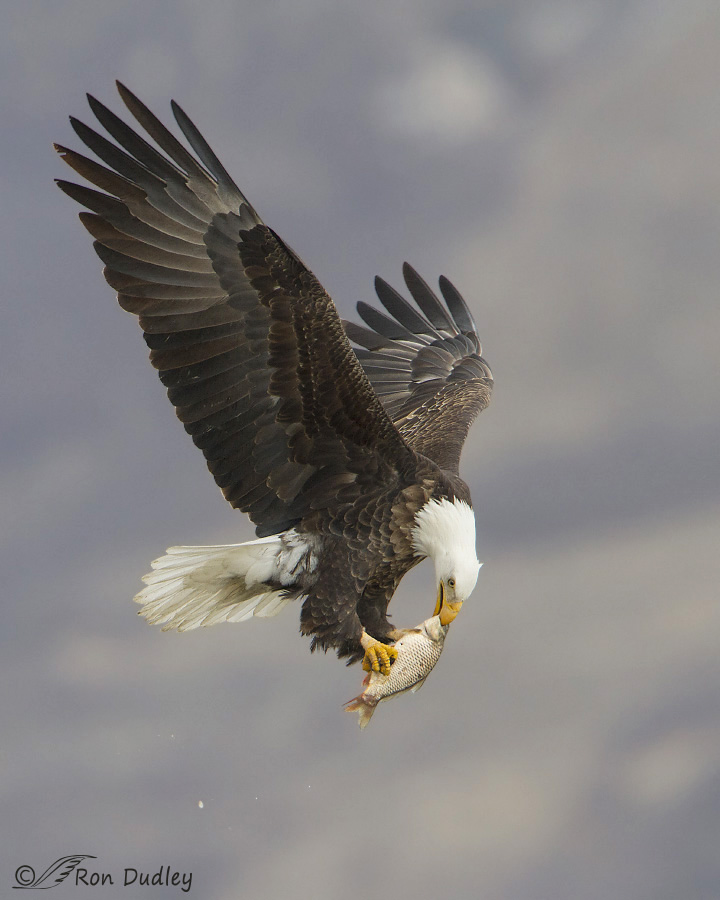
They are Great Photos. I have been watching -Southwest Florida Eagle Cams -Since Last Year. Harriett and M15 – Great Bald Eagles/Parents to
E9 That Hatched December 31st 2016. These Amazing Life has come into this world. Many Wildlife out there, but The American Bald Eagle- is Number 1. I am from Canada and enjoy watching the Cams/Pictures and Comments from People all over the World. Thank you for this site of great work put together.
Thank you From -Toronto, Ontario, CANADA
Excellent post with such useful information and elegant photos!
Thank you, Ken.
What an awesome article Ron! Thank you, I really learned a lot. I am also blown away at how each image is tack sharp and perfect. I have some very good raptor text books, and your article on eagles blows them away. Thanks again !
That’s very high praise, Ed, and it’s so much appreciated. Thank you.
As usual, Ron, you answered every question that popped into my head and more. Your written details are excellent and if the reader misunderstands, your beautiful images tell it all.
I hope you don’t mind but again, I am sharing this excellent post with my birding groups in Canada. Around the Southern Ontario area of Canada, Bald Eagles have made a significant comeback and are nesting here. In Nova Scotia on the Atlantic Coast, Bald Eagles have been numerous for many years, even when they were threatened in the U.S.
I’m sure all the members will appreciate your knowledge and expertise.
Happy Thanksgiving to you and yours, Ron.
PS: Right now I am enjoying the birds of Botswana as I spend time in this wonderful part of Africa. Lots of lifers!
Judy, Share away! If posts like this make folks appreciate and respect birds even more I’m all for it.
Your time in Botswana sounds like a dream trip!
When I taught at at the childrens’ rehab. hospital. One of my students was the teenage son an official from Botswana. He’d received a head injury in a car crash. Every time we looked at each other, we’d start laughing…it was crazy! I used to like to rub his nose which was a little lighter in color…(from all the rubbing?). We were good buddies…I miss him….a lot!!!
Great write-up Ron. I find it very helpful in my eagle watching! Do you think there are many differences in eagles geographically? I live in Central Florida and see many eagles. I’m just wondering if the cycle (plummage, colors, etc), are the same. Thanks!
Thanks, Cat. As far as I know Bald Eagle plumage/colors at different ages are very similar throughout their range.
Ron, I share other’s comments such that this is a beautiful and educational posting. Both the Bald Eagles and the Golden Eagles are spectacular looking birds…very majestic. I hope I get to see either or both of them in my lifetime.
Thanks for the posting and have a Happy Thanksgiving!!
I hope you get to see them both, Alice. I’ve been lucky enough to see and photograph both species within just a few minutes of each other.
Thank you so much for the magnificent photos and the id lessons. Now I live in Cuernavaca, Mexico, further south from the capital and where we see a completely different variety of song birds and raptors. It is unlikely we will ever see a bald eagle in this region mainly because it is not their range. I have seen bald eagles perched and in flight in the northern part of the country, closer to Texas especially near the Rio Grande. I also recommend Jerry Liguori’s book on raptors from every angle. Also super helpful is the Crossley ID raptor guide that Liguori publishes with Richard Crossley and Brian Sullivan. Greetings!
Kim, in my view Jerry’s raptor knowledge is unsurpassed. And I can vouch for the fact that he knows ALL OF IT off the top of his head! He’s amazing to have around anytime but especially when there are raptors around.
I need to begin with a hearty THANK YOU for all the work you do here. What a joyous way to begin my day (even if the day’s half gone before I get here). Along with your stunningly beautiful images, you almost always take care of that learning-something-new-every-day thing and that almost always saves me a lot of time and effort…LOL! Not today, though. I knew this progression in bald eagles and the difference with goldens. But seriously, THANK YOU! You and Mia are a delightful pleasure!
And a happy Thanksgiving to everybody!!
I’m glad you appreciate all the work, Laura. That helps to make it all worth it!
I’m so glad you updated and ran this post again! MAGNIFICENT* shots of MAGNIFICENT* birds!!!!! (*continue to add favorite superlatives ad infinitum!)
I’m particularly partial to this post because it was a link to the original from dceaglecam chat that first drew me to your blog a couple of years ago. It was “love at first bird” and I’ve been hooked ever since!
Happy Thanksgiving to everyone who is celebrating and have a marvelous Thursday tomorrow to all. I am eternally thankful for the beauty of this blog community!
Marty, eaglecams and similar sites are part of the reason the original version of this post has had so many views. I’m very glad you were among them! It wouldn’t be the same around here without you.
Thanks, Ron. *blush*
I will probably never see either a Golden or a Bald Eagle (of any age) for myself but loved this lesson. And the images.
Megathanks – and a Happy Thanksgiving to you and yours.
Like Patty said, I feel rich, too, knowing that we have two lovely eagles, three if you count Ferrugs and I do) and redtails! I’ve often thanked the Universe for putting me here with these outrageous birds!
It’s easy to count Ferrugs as eagles, Laura. Many folks, including some experts, already do.
I had another senior moment and forgot about ospreys. If I only had a brain…
My Lakota friends called the Redtailed Hawk the eagle’s (golden) little brother….I think of them that way….lucky you!!!
At least you folks in Australia have the Wedge-tailed Eagle, EC. That’s a pretty darned impressive stand-in!
Just have to comment, again…thanks to this posting, I FEEL RICH!!!!
Don’t spend it all in one place, Patty!
Very helpful series, Ron. Wish we had more opportunity to see them in our area… They are coming back!
I wish you did too, Dan. And yes, they are!
Breathtaking!!! Wonderful lesson!
Thanks, Eloise.
These images are breathtaking. And very informative. I learned a lot new today.
Good! Glad to hear that, Eloise.
Wow! Tremendous photos! Thanks for going through the different Bald Eagle molts with words and photos; I enjoyed seeing the changes. The last photo is amazing!!!
I’m glad you think that photo is special, Myriam. So do it.
Hey teach, you’ve done it again – given a fantastic lesson, with awesome images, Well Done!
Living in the east I use two major clues that you outlined! Is the bird near, over or beside water – probably a Bald Eagle, but still need to check field marks..
Over land either cruising or perched, look at the head and neck area, is it golden, yellow to tawny brown, a Golden Eagle.
However, I have seen Goldens flying over trees beside a river that empties into a lake, so one needs to be cognizant of the field marks!
Many thanks for lesson, great post!!
BTW – You and Mia have a great Thanksgiving, eat hearty enjoy the time!!
I’ve also seen an occasional Golden near water but only rarely. An example would be one I photographed near Flaming Gorge reservoir and there was actually a nesting pair of Bald Eagles nearby. Happy Thanksgiving to you too, Dick.
WOW! WOW! WOW! I’m taking this posting “personally”!!! As if it was tsilor-made for me…..PERFECT!!! Love it!!! Thank you!!! Drooling over every, single image…hard to pick a favorite, but one of the golden flying probably is one of them…thanks ,again. HAPPY THANKSGIVING, EVERYONE. I’m especially thankful for getting to “know” all of you, especially you and Mia, Ron.I THANK THE EAGLES FOR THIS!0
Same to you Patty, have a Great Thanksgiving!!
Knowing you I figured you might enjoy this more detailed version of the post, Patty. Thanks very much.
Guess I’ve come full circle with this one…this is similar to what got me hooked on your stuff, Ron….now I’m addicted!!!
And what a sweet obsession it is!
Awesome informative series Ron!
Charlotte
Thanks, Charlotte.
This is a wonderful post. I love the educational aspect of your work as well as the beautiful pictures. I have been to Alaska and seen so many there. They seem as plentiful as sparrows and are very majestic. Wonders of the world.
Betty, Agreed – eagles of any species are spectacular birds.
Another great tutorial & photo series, thank you!
Thanks, Elmer.
Thanks for the beautiful photographs and educational post!! I learn so much from your blog.
You’re very welcome, Joanne.
Very helpful post, though I think one would have to do a lot of study to not be confused by the maturity stages of Bald Eagles. I think they, along with various Gulls have the most complicated plumage changes as they mature. Supposedly we have Goldens at the park, but I have yet to see one. I think I thought I saw some Goldens on Kodiak Island some years ago, but based on what you’ve said in this post, I am now pretty sure they were juvenile Balds.
I’ll bet your Kodiak eagles were immature Balds too, Susan. Personally I don’t even try with gulls – they overwhelm me and I have more interests (and challenges) in other groups of birds.
Beautiful images, especially of the sub-adults! I also wonder why the mature adults will tolerate a sub-adult around, especially with their own fledglings. I didn’t think they would recognize their offspring from previous years. Wonderful job catching these photos!
Carol, it’s not a matter of toleration as much as it is the fact they had no choice. When conditions are right (very cold winter and lots of dead carp concentrated in a relatively small area) eagles have no choice but to feed in close proximity to each other. And there’s many, many fights.
Ron – that last image is just spectacular! What a moment you captured there. That’s pretty special.
Thank you, Kevin.
Thank you so much for the info and the beautiful photos! Last year my 4 juvenile eagles here in North Florida had a lot of mottling underneath while they were still in the wingersizing stage and couldn’t fly. Is that unusual?
Gail, I’m not sure how to answer your question because I’m unsure about what you mean when you say “wingersizing” stage…
Sorry! Our local Eagle Watch group calls it wingersizing instead of exercising when the eagles hop and flap around in the nest tree, getting ready for their first flight, and first landing! I couldn’t find a way to attach a photo, but during this stage you can see the underside of the wings quite well. In all 4 of the eaglets I watched grow up last year, the underside was very noticeably mottled in appearance at this stage.
Ok, now I get it (a little slow on the uptake…).
No, I don’t think it’s unusual. Here’s what Jerry Liguori has to say about it in his book:
“Juvenile bald eagles are mostly blackish underneath with white axillaries and varying amounts of white along the underwing coverts and secondaries”.
At the Cornell Redtail Hawk Nestcam, we called that stage of development flappercizing. And boy was it a challenge to keep up with three baby redtails on the cam, while they were trying out those new wing/feather thingies, figuring out how the controls worked!
Beautiful!!! Awsome!!!! And one of my favorite pictures of yours the eagle feeding while flying !!!!!
That image is one of my favorites also, Marina.
This was really interesting, especially the photos with a few eagles in various stages of development shown together. I had no idea that it took so long for bald eagles to acquire their white heads and tails. One of the things I’ve noticed here in Minnesota the past several years is that bald eagle sightings are not as rare as they were when I was a kid. They are really beautiful creatures.
Kathleen, Bald Eagles (along with some other top predators like Ospreys) began a dramatic comeback after DDT and similar pesticides were banned back in the early 70’s.
I’m so glad that you published this wonderful series— I hadn’t seen the original version. As there are several pictures which contain 2 stages of immatures with a full adult, i wondered– was
that happenstance, or do family units stay closely linked for a number of years ?
“do family units stay closely linked for a number of years?”
No, they don’t, Kris. Juveniles disperse away from siblings and parents at 4-11 weeks after fledging.
Wonderful photo’s and commentary, Ron! Thx for the lesson on Bald vs. Golden. We do get both here tho I suspect some of what we “think” are Golden are actually immature Bald. I tend to look for a definite white patch on the lower side if the wing for Golden………. Is that a clue or not?
Yes, Judy – varying amounts of white in underwing coverts can be a clue in some ages of Bald Eagles.
Awesome and informative post Ron. Great pics and info. I think this may have been the post I found on the net several years ago when I first reached out to you. I sent you a few photos and asked your thoughts on what type of eagle I had captured in some pics southern Ontario. And you let me know it was a juvenile bald something, I had never seen in the wild before or since. Keep up the awesome posts.
I think I remember you sending me those photos, Colin.
Great info and beautiful photos.
Now….if only I can remember all of this.
Remembering comes with practice, Judy (and at my age I have to practice a lot! )
)
Thanks for the lesson on identity, especially with photos!
You’re very welcome, Donald.